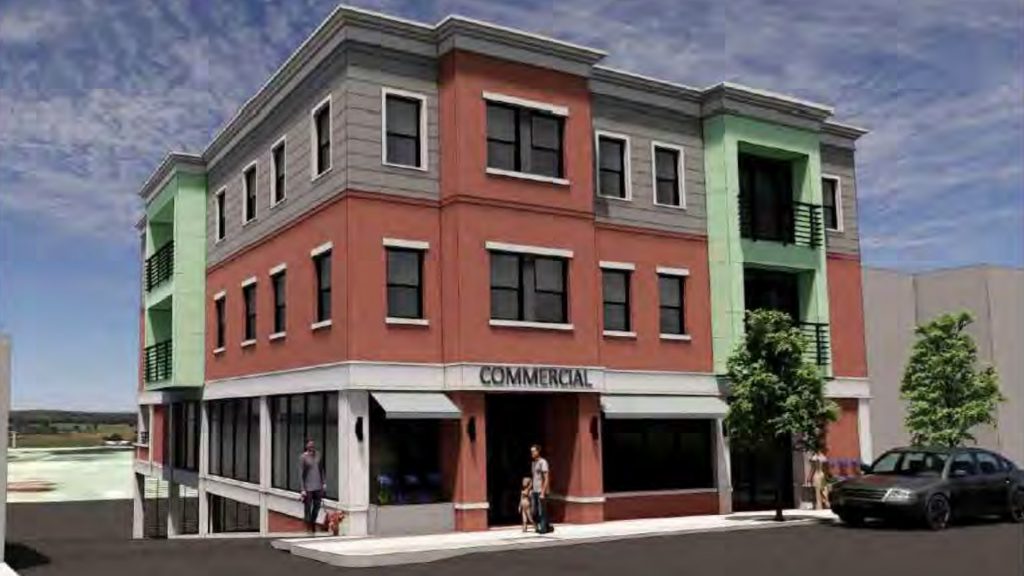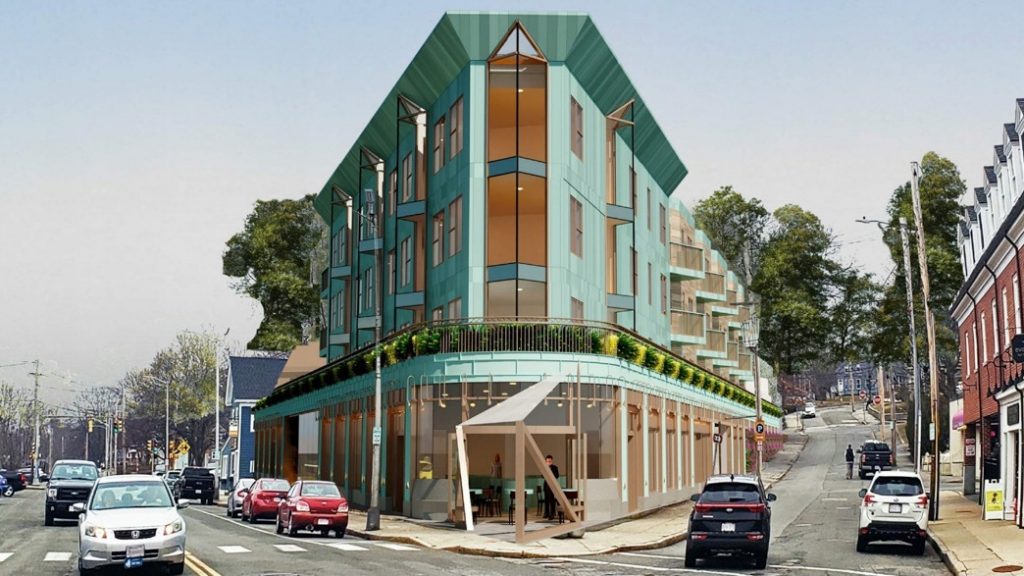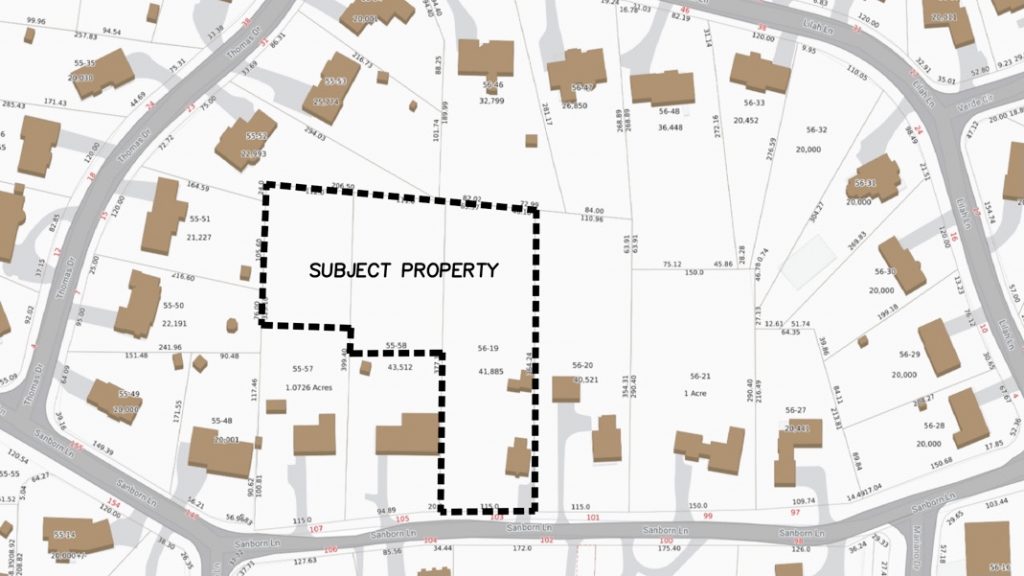Reading, MA — By a vote of 5-0, the Community Planning and Development Commission (CPDC) approved a proposed development at 18 Woburn Street on Monday. The project, a three-story building, would house 2,427 square feet of retail space on the ground floor facing Woburn Street with six apartments spread over the two floors above. Project engineer Giovanni Fodera shared that his team had answered all outstanding issues posed by the town’s engineering department. This included plans to “fine tune” the grading of the entrance into the lower-level parking garage.

After conducting a study on the issue, Samuel Gregorio, traffic engineer, reported the five most popular compact cars would have no issues “bottoming out” as they enter or leave the garage. “Pretty much every car gets in and out of the driveway,” Gergario explained. He continued to state that the only vehicles with difficulty are low-riding sports cars.
CPDC member John Weston expressed concern over the integrity of the column at the southeast corner of the building. “I can tell you two, three, or four cars a year will hit that column,” Weston predicted. He continued, seeking assurance that the column, which supports an upper deck, would be engineered to withstand these impacts. Architect John Seger suggested that the corner could be designed with a larger steel column in that location. He also suggested that a continuous bearing wall could be placed to take the load.
CPDC next opened a continued public hearing reviewing plans for a proposed new four-story development at 6-16 Chute Street, now rebranded as 45 High Street. The current building on the 17,986 square foot site, which was built in 1974, is a one-story commercial building that houses several businesses, including the Last Corner Restaurant, The Green Tomato, and a laundromat.

The proposed building would create two commercial spaces on the first floor facing High Street with an enclosed parking garage, to be used by residents, also on the first floor. The garage would be accessed via a Chute Street entrance. The upper three floors would house 12 two-bedroom apartments and 20 one-bedroom apartments. Twenty-five percent of the apartments would be designated as “affordable.” Entrances to the residential portion of the building would also be both on High Street as well as on Chute Street.
Architect Jeffrey Olinger explained that the engineering department had accepted drainage plans for the project. He also submitted lighting and noise surveys, suggesting that the results indicate that both fall within acceptable levels. CPDC member Nick Safina suggested that a study of current noise conditions could be useful to combat future noise complaints.
CPDC member Heather Clish continued to express concern over the design of the open space area at the corner of Haven, High, and Chute Streets. CPDC received communication from residents expressing similar concerns. Olinger tried to explain that there are actually three open space areas totaling over 800 square feet in the project. Clish responded with skepticism regarding the use of a second-story roof deck as a publicly usable open space. Property owner James Gerrity responded that he wants to wait to determine the town’s plans for the intersection before finalizing a design for the space. He also highlighted that the proposed indoor space at the corner of the building could be designed to feel “less private.”
Select Board chair Karen Herrick questioned the developers regarding the energy infrastructure of the building. Olinger assured the CPDC that the “framework” for a “net-zero” building would be included in the plans. He also shared that “the goal is to use heat source pumps” for heating the building.
Residents Robert Coulter and David Talbot complained about the size and density of the building. Stempeck also complained regarding the visual impact of several already completed projects. Speaking for the developer, Attorney Josh Latham shared that Massachusetts General Law section 40R was developed to help towns develop a combination of affordable housing, retail spaces, and design approvals in exchange for additional density waivers, which keep projects economically viable. Stempeck, while expressing approval of the policy, still suggested that the project needs to be “a little bit smaller.”
When pressed on economic viability by Safina, Gerrity explained that the dilutive effect of one “affordable” unit is two and a half market-rate units in a building. When Safina suggested a building size of 24 to 28 units, Gerrity responded, “unit count does not necessarily dictate building size.” He also expressed frustration that other projects in town have been approved with the density that he is asking to be granted. CPDC continued the public hearing to January 24 at 7:30 pm.
By a vote of 5-0, CPDC approved a definitive subdivision plan for 103 Sanborn Lane. The developer, Chimney Hill Real Estate, proposes demolishing the house and shed at the current address and building a road with a cul-de-sac to three separate lots, each in excess of 20,000 square feet. Attorney William Crowley, speaking for the developer, explained several waivers that the developer is asking for, including a smaller right of way for the road, the width of the road, and the waiving of the diameter of the cul-de-sac. Other waivers the developer requested include a traffic study and the building of an island in the cul-de-sac. By a vote of 5-0, the CPDC also approved all the requested waivers.

CPDC endorsed an “approval not required” plan for 89 King Street and 90 Prospect Street by a vote of 5-0.
CPDC adjourned at 12:10 am.
